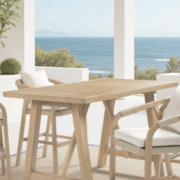The best in the business rely heavily on their employees to communicate the benefits and advantages of a retailer’s inventory in person and face-to-face with the consumer.
More training in sales, or product knowledge, or simple communication?
Or is it finding a way to walk that fine line between being a help and being a bother? Several experienced retailers gave us their take on the ins and outs of sales associates.
Scott Horvath, owner of O’Malia’s Living in Carmel, Indiana, says that knowing who you are talking to is the first step.

“We treat our customers as families,” Horvath says. “All of our customers are families, friends or neighbors. We live, work and play next to our customers. We are not that big to not have some kind of connection to everyone who walks into our store.”
Horvath says it is helpful to remember that there’s help out there.
“One of the best developments in the last year was the ICFA Sales Training program by Bob Phibbs,” Horvath says. “The timing was impeccable and the knowledge was valuable in setting our team up to be moving in the right direction. During the pandemic, we never lost a sales employee. The training helped reenergize the team and keep them focused.”
At Weir’s Furniture, with four stores in the Dallas/Fort Worth area, Amy Folmar, marketing director, said that consumers are first engaged with a warm and friendly welcome – but they don’t go too far.
“The Weir’s way is to welcome and greet our customers and offer to help them find anything they need,” Folmar explains. “If they want to look, it is our policy to leave them alone and not to follow them or hound them.”
Any sales tactics or conversation starters?
“Just a warm, friendly and genuine welcome,” Folmar says. “Our true passion really is serving our guests and helping them make their house a home!”

Jack Wills III, president of Jack Wills Outdoor Living in Tulsa, Oklahoma, says that all customers are acknowledged within five or 10 seconds of walking in.
“We do not approach them until they settle into the store,” Wills says. “We then introduce ourselves and let them know about the company and tell them about our layouts and specials that might be available. We will then inquire about any projects they might be working on currently, like pool construction or remodeling or a patio addition.”
Wills says that it is important to come across as low-pressure. “Learn how to just visit and get to know the person and what their needs are,” he says. “You must come across as a genuine person to move on to a trust factor,” said Wills. “Consumers see right through the BS factor.”
Lee Recchia, president of American Casual Living in Suwanee, Georgia, says his sales associates first greet customers, then begin to find out from them how they may be of assistance.
“A warm, welcoming greeting upon entry is paramount,” Recchia explains. “We ask if there is something specific they are seeking. We explain how our store is organized, how the pricing is presented, how to identify specials, etc., and we encourage them to tour the store. We let them know that we are available at their call to answer questions or to demonstrate products. While they tour, there’s much to learn from observation — their preferences for styles, comfort, price levels, configurations, etc. So we monitor their progress from a comfortable, nonintrusive distance, and check in with them periodically.”

As far as starting conversations, American Casual Living prefers asking to telling.
“As specialty retailers, we feel our mission is not so much to ‘hard sell’ as it is to guide a consumer to the purchase,” Recchia says. “Once engaged, conversations naturally evolve from ‘where they are’ to ‘where they want to be.’ We find that most consumers are well-studied in the category and have a reasonably developed vision of what they desire and a good understanding of market pricing. Oftentimes their vision is inspired by their travels, a neighbor’s home, by a magazine or online image, or simply by a desire to update their ‘look,’ or to acquire greater comfort, utility, etc.”








